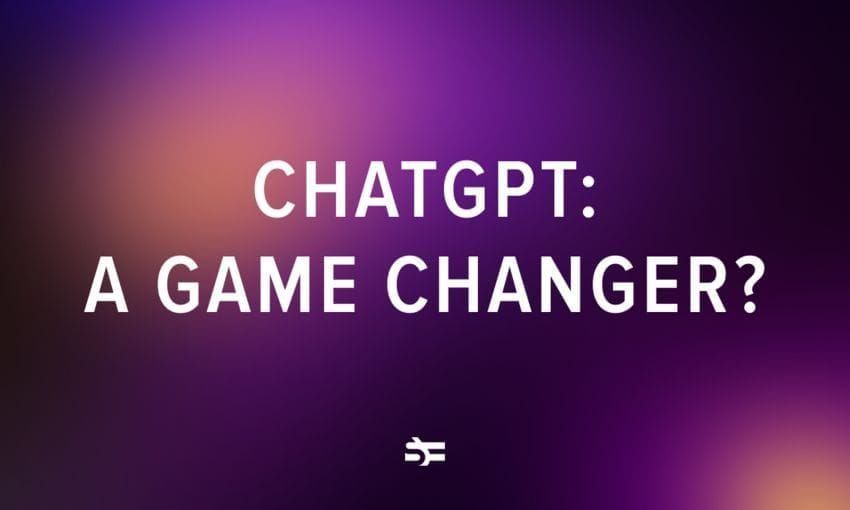Every blockchain user cares about fast and secure transactions and wants to have the flexibility to work with different cryptocurrencies from the same interface.
The primary goal of blockchain development today is achieving near-instant cryptocurrency transaction speeds. For that, a blockchain must be scalable, meaning capable of handling a high volume of transactions without compromising security or decentralization.
Another important aspect is blockchain interoperability—the ability of different blockchain networks to communicate, share data, and interact with one another, providing users with secure cross-blockchain functionalities.
In this blog, we examine the various challenges related to blockchain scalability and interoperability and the proposed solutions.
What is blockchain scalability?
Scalability is the ability of a blockchain network to handle an increasing number of transactions and users efficiently. It involves enhancing the network’s capacity to process transactions quickly and cost-effectively while maintaining security and decentralization. Scalability is a critical factor in blockchain networks because the size and complexity of the network grow with each transaction added to the chain.
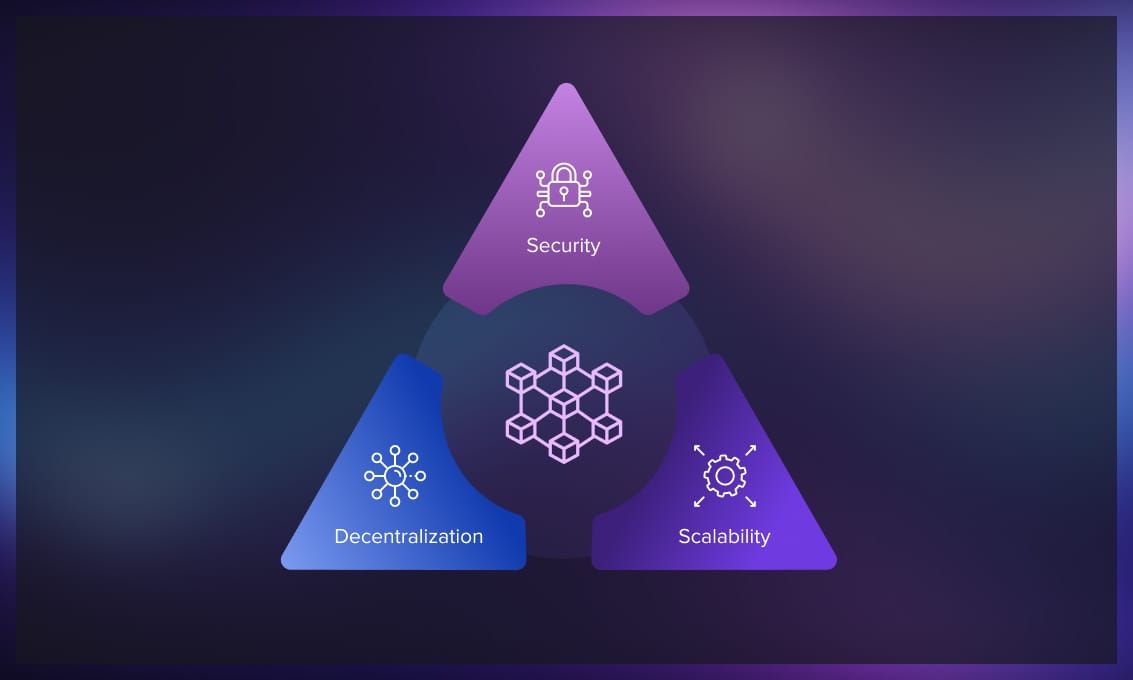
When a network cannot handle the transaction load, it results in slow processing times and a poor user experience. These issues are especially important for applications requiring high transaction volumes, such as decentralized finance (DeFi) and supply chain management. Therefore, scalability is essential for the future growth of blockchain technology.
How to improve scalability in blockchain?
Achieving high transactions per second (TPS) rate requires nodes to confirm blocks quickly, following specific guidelines that define valid transactions and determine who can process and add them to the blockchain.
Larger block sizes can enhance transactional capacity by enabling more transactions to be included in a block, allowing the entire blockchain to keep up with increasing data usage and exchange.
Beyond speed and size, the potential for future innovation is a key characteristic of a scalable blockchain. Whether in business, healthcare, or education, scalable blockchains can meet users’ evolving needs by adapting the technologies they rely on daily.
Elements of a scalable blockchain
Blockchain scalability is assessed based on five criteria:
Capacity
Recording data differs from storing it, and nodes can optimize and prioritize either or both tasks to meet the clients’ needs. Each node can handle large data volumes if it has sufficient storage capacity.
Networking
Most of the required network bandwidth is distributed evenly between block confirmations. When a block is discovered, nodes work to transmit the block data across the blockchain. This extensive use of network resources can cause delays unless efficient data transmission mechanisms are in place.
Throughput
Blockchain throughput refers to the block size and the time needed to confirm a transaction within that block. A bigger size block can increase the number of transactions it processes, verifies, records, and stores.
Finality
Blockchain finality is the point at which a transaction is recorded on the blockchain and considered irreversible, ensuring that it cannot be altered or undone. This concept guarantees the security and integrity of transactions within the blockchain network.
Confirmation time
Confirmation time is the average duration between submitting a transaction to the network and recording it as a verified block. Faster block generation and quicker transaction confirmations directly contribute to higher transaction throughput and increased user satisfaction.
What is the blockchain scalability trilemma?
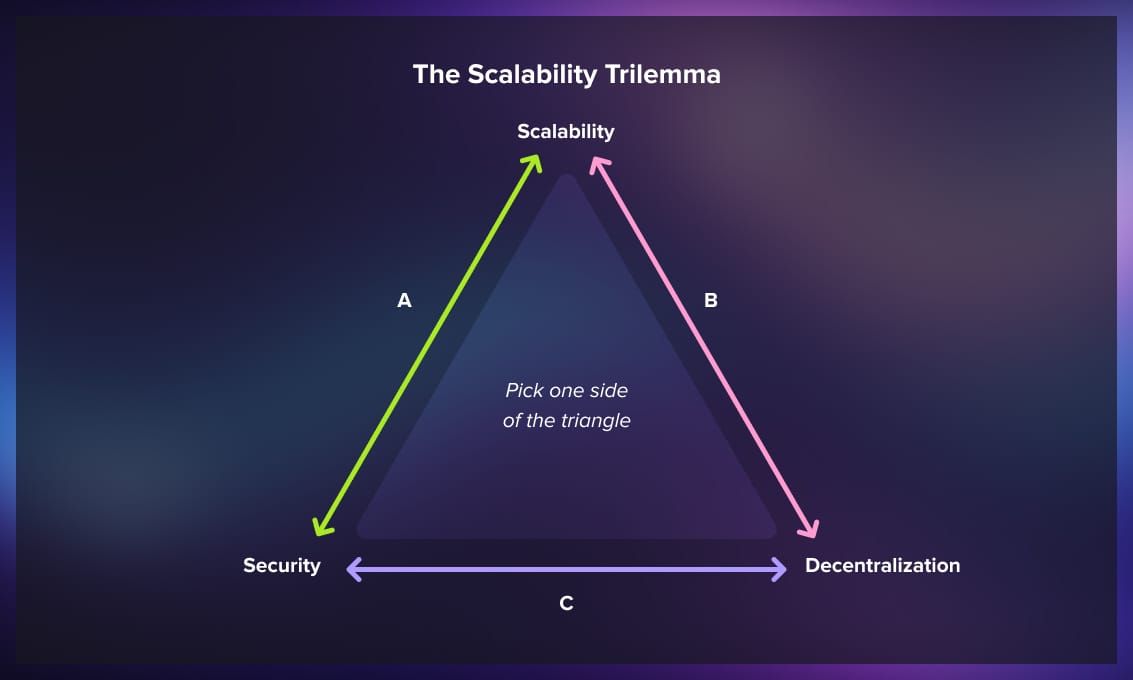
The Blockchain Scalability Trilemma is a concept introduced by Vitalik Buterin, the co-founder of Ethereum. It refers to the challenge in blockchain development of achieving three key attributes simultaneously: decentralization, security, and scalability. The trilemma suggests that it is difficult, if not impossible, for a blockchain to optimize all three points at the same time. Here’s a breakdown of each attribute:
- Decentralization: This refers to the extent to which a blockchain is operated by a distributed network of nodes, rather than being controlled by a single entity or a small group of entities. High decentralization means more nodes participate in validating and verifying transactions, making the network more resilient and less susceptible to attacks or failures.
- Security: Security ensures that the blockchain is resistant to attacks and that transactions are secure and immutable. A highly secure blockchain prevents double-spending, protects user data, and maintains the integrity of the network even in the presence of malicious actors.
- Scalability: Scalability refers to the blockchain’s ability to handle an increasing number of transactions and users without compromising performance. A scalable blockchain can process more transactions per second (TPS) and support a growing number of applications and use cases.
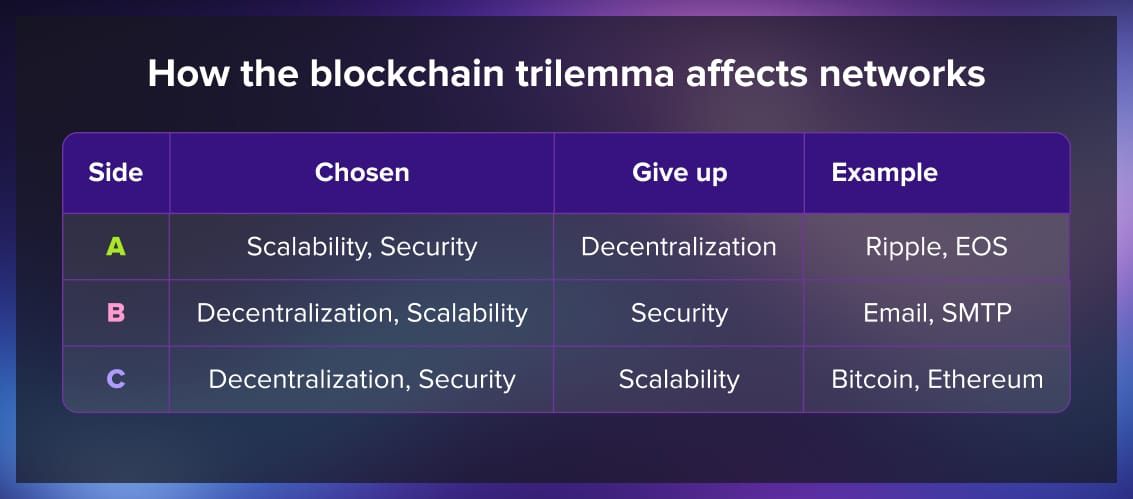
The trilemma posits that improving one or two of these attributes often comes at the expense of the third. For example:
- Improving scalability: Increasing the number of transactions per second might require larger blocks or faster block building times, which could reduce decentralization by making it harder for smaller nodes to participate or by requiring more powerful hardware. This could also impact security if the changes make it easier for malicious actors to compromise the network.
- Enhancing security: To enhance security, a blockchain might use more complex consensus mechanisms or cryptographic techniques, which can increase the computational requirements and slow down transaction processing, thus reducing scalability.
- Increasing decentralization: Ensuring that more nodes can participate in the network can make consensus slower and more resource-intensive, impacting both scalability and potentially security if the network becomes more vulnerable to certain types of attacks.
Blockchain scalability solutions
Developers and researchers in the blockchain space are continuously working on innovative solutions to address the scalability trilemma. These solutions aim to achieve a balance between decentralization, security, and scalability. Some of the approaches include:
1. Layer 1 solutions
First-layer solutions involve changes to the main blockchain network’s codebase and are therefore also known as on-chain scaling. Layer 1 solutions focus on enhancing the core features of the blockchain network, such as increasing the block size limit or reducing block verification time. Popular layer 1 scalability solutions include sharding, Segregated Witness (SEGWIT), and hard forking.
Sharding
Sharding divides the blockchain network into smaller, more manageable parts called shards that operate in parallel, each processing its own set of transactions. This division increases the overall processing capacity of the network, as its performance becomes the sum of multiple parallel transactions. Sharding effectively eliminates the dependence on individual node speed for improved transaction throughput.
Segregated witness (SEGWIT)
SEGWIT is a protocol improvement in the Bitcoin blockchain that changes the way data is stored. By removing the signature data associated with each transaction, SEGWIT frees up space to store more transactions. Digital signatures, which verify the ownership and availability of the sender’s funds, take up about 70% of the transaction space. Removing this data increases the capacity for additional transactions.
2. Layer 2 scalability solutions
Layer 2 scalability solutions are designed to address the scalability challenges by building additional layers on top of the existing blockchain infrastructure. On this layer, intermediate transactions can be performed and validated in bulk, thus enhancing the throughput and transaction speeds of blockchain networks while maintaining their security and decentralization.
Sidechains
Sidechains are separate chains that run parallel to the main blockchain, allowing for increased throughput and scalability. They can be used for specific applications or use cases, enabling faster transaction speeds while still being connected to the main chain for security.
Examples of sidechains include:
- Liquid Network (Bitcoin): A sidechain-based settlement network for traders and exchanges, providing faster and more confidential transactions.
- Rootstock (RSK): A smart contract platform that is connected to the Bitcoin blockchain via a two-way peg, enabling smart contracts with Bitcoin’s security.
State channels
State channels allow participants to conduct a series of off-chain transactions that are only recorded on the main chain when necessary. This reduces network congestion and improves transaction speeds. Examples include:
- Raiden Network (Ethereum): A payment channel network for Ethereum, similar to the Lightning Network for Bitcoin.
- Celer Network: A layer 2 scaling platform that uses state channels and other techniques to achieve high throughput and low latency.
Rollups
Rollups are a layer 2 scaling solution that involves bundling multiple transactions into a single transaction, which is then submitted to the main chain. Rollups can be either optimistic or zero-knowledge (zk-rollups):
- Optimistic rollups: Assume transactions are valid by default and only run computations in case of a dispute. Examples include Optimism and Arbitrum.
- zk-rollups: Use zero-knowledge proofs to ensure the validity of transactions, reducing the computational load on the main chain. Examples include zkSync and Loopring.
Plasma
Plasma is a protocol that creates decentralized applications within sidechains, allowing for increased scalability by processing transactions separately from the main chain while still being anchored to it for security.
Interoperability protocols
These protocols aim to bridge different blockchains together, allowing for the transfer of assets and data between them. By providing interoperability between blockchains, they can increase overall scalability by distributing transactions across multiple chains.
3. Consensus mechanisms
Developers are exploring innovative consensus mechanisms to improve scalability while maintaining security and decentralization. Examples include:
- Proof of Stake (PoS): PoS replaces the energy-intensive Proof of Work (PoW) with a system where validators are chosen based on the number of coins they hold and are willing to “stake” as collateral. Ethereum 2.0 is transitioning to PoS.
- Delegated Proof of Stake (DPoS): DPoS involves a small number of elected nodes (delegates) responsible for validating transactions and creating blocks. Token holders can vote out underperforming or malicious validators, making DPoS a collaborative consensus mechanism compared to competitive mechanisms like Proof of Work or Proof of Stake. In DPoS, delegates work together to ensure block production. Despite its partial centralization, DPoS blockchain networks typically offer better speed than traditional public blockchain networks.
- Proof-of-Authority (PoA): This consensus mechanism employs a reputation-based algorithm. In PoA, selected nodes are responsible for validating transactions within the network. These nodes function as system administrators, dictating the state of transactions on the blockchain. Participants in a PoA-based blockchain must stake their identities, necessitating a comprehensive and stringent screening process for selecting validators. The identity-based model and higher throughput of PoA make it suitable for private, permissioned blockchain systems.
- Byzantine Fault Tolerance (BFT): BFT consensus mechanisms are trusted solutions for addressing the Byzantine Generals Problem. BFT ensures that a distributed system can achieve consensus consistently, even in the presence of adversarial agents within the network. There are various variants of BFT algorithms that serve as effective solutions for enhancing blockchain scalability.
4. Scalable distributed ledgers
By distributing the workload across multiple nodes in a decentralized manner, scalable distributed ledgers can handle high transaction volumes while maintaining transaction speeds and network capacity.
What is blockchain interoperability?
Blockchain interoperability is the ability of different blockchain networks to communicate, share data, and interact with each other seamlessly. This means that assets, information, and transactions can be transferred across various blockchain platforms without intermediaries.
Interoperability aims to enhance the functionality and utility of blockchain systems by enabling them to work together. This allows for broader adoption and more versatile applications, creating a more interconnected and efficient ecosystem.
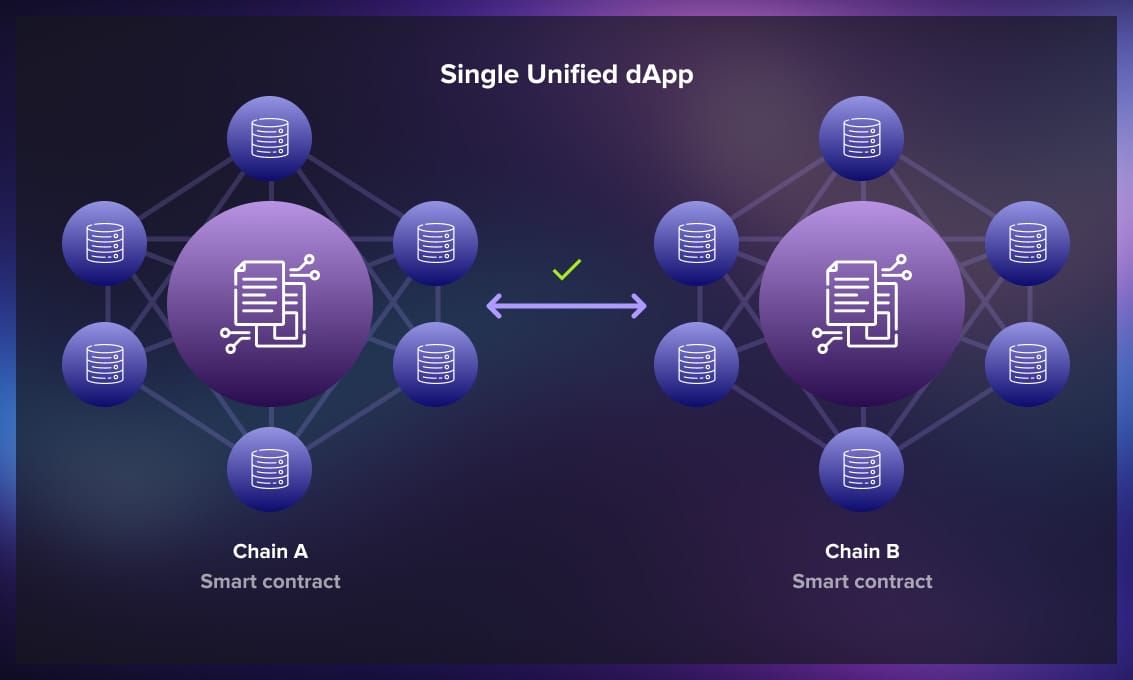
Blockchain interoperability is becoming a key requirement as Web3 has developed into a complex landscape, featuring over 100 layer-1 blockchains and a growing number of layer-2 and layer-3 networks. Various blockchains compete by optimizing protocols for specific features, often balancing trade-offs between decentralization, censorship resistance, throughput, and privacy.
Interoperability is crucial for developers creating cross-chain or modularized applications that maintain a unified global state and liquidity across different on-chain environments. It is also essential for application developers who want to utilize the unique assets and features of each blockchain.
How to achieve blockchain interoperability?
Key components of blockchain interoperability include interoperability bridges, cross-chain communication protocols, atomic swaps, and other tools.
Interoperability bridges
Interoperability bridges, such as the Cosmos Network, enable the exchange of information and assets, using the Inter-Blockchain Communication (IBC) protocol. These bridges are instrumental in breaking the isolation of blockchain networks and establishing seamless connections.
Cross-chain communication protocols
Cross-chain communication protocols, like Polkadot’s Relay Chain and Parachain system, are key in standardizing data exchange and transaction verification between blockchain networks. These protocols ensure compatibility and seamless transfer of assets and information.
Atomic swaps
Atomic swaps use smart contracts to ensure both parties receive their assets or the transaction is canceled. For example, a Bitcoin-Ethereum atomic swap involves smart contracts executing the exchange based on predetermined conditions, enhancing security and decentralization.
Sidechains and pegged assets
Sidechains are parallel blockchains facilitating asset transfer alongside the main blockchain, while pegged assets are tokens on one blockchain pegged to equivalent tokens on another. The Liquid Network, a Bitcoin sidechain, allows seamless BTC token transfers, creating interconnected pathways.
Middleware solutions
Middleware solutions act as intermediaries between applications and blockchain networks, providing abstraction layers for translating and relaying information. Chainlink, for example, offers decentralized oracles to securely transmit off-chain data to smart contracts on different blockchains. Middleware solutions enable developers to build decentralized applications interacting with multiple blockchains, enhancing interoperability and expanding blockchain technology’s potential.
Conclusion
Blockchain’s scalability and interoperability are essential for the development of decentralized apps. Scalability solutions enable higher transaction throughput, lower fees, and improved overall performance. The choice depends on the specific goals and needs of the application or network. Layer 1 solutions are most effective for enhancing security and decentralization. Layer 2 solutions can improve performance without compromising security. Consensus mechanisms maximize scalability while maintaining security and decentralization.
Interoperability protocols enable complex applications to function as a unified entity across multiple blockchains and empower organizations to securely access any on-chain environment from a single interface. These advancements are key to developing next-generation nets and dApps.


.png)



.jpg)
.jpg)
